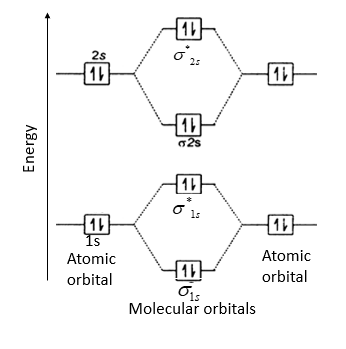
Bond order of \[\text{B}{{\text{e}}_{\text{2}}}\] is
A. 1
B. 2
C. 3
D. 0
Answer
558.6k+ views
Hint: According to the molecular orbital theory, the bond order is defined as the number of covalent bonds in a molecule. Bond order is equal to half of the difference between the number of electrons in bonding (\[{{N}_{b}}\]) and antibonding molecular orbitals (\[{{N}_{a}}\]).
Complete Solution :
\[\text{B}{{\text{e}}_{\text{2}}}\] molecule will be formed by the overlapping of atomic orbitals of two beryllium atoms.
A Be atom has four electrons. It has two valence electrons and its electronic configuration is \[1{{s}^{2}}2{{s}^{2}}\]. Therefore, \[\text{B}{{\text{e}}_{\text{2}}}\] molecule has eight electrons which are to be filled in four molecular orbitals.

Thus, electronic configuration of \[\text{B}{{\text{e}}_{\text{2}}}\] is \[{{\left( \sigma 1s \right)}^{2}}{{\left( {{\sigma }^{*}}1s \right)}^{2}}{{\left( \sigma 2s \right)}^{2}}{{\left( {{\sigma }^{*}}2s \right)}^{2}}\]
Here, bonding electrons, \[{{N}_{b}}\] = 4 and anti-bonding electrons, \[{{N}_{a}}\]= 4
Therefore, bond order (B.O.) of \[\text{B}{{\text{e}}_{\text{2}}}\] molecule is
\[\begin{align}
& \text{B}\text{.O}\text{.=}\frac{1}{2}({{N}_{b}}-{{N}_{a}}) \\
& \text{B}\text{.O}\text{.}=\frac{1}{2}(4-4)=0 \\
\end{align}\]
- Zero value of bond order corresponds to non-existence of \[\text{B}{{\text{e}}_{\text{2}}}\] molecule.
So, the correct answer is “Option D”.
Note: The bond order of a molecule conveys the following information:
1. The stability of a molecule can also be expressed in terms of bond order. Higher the bond order, more stable is the molecule.
2. Bond length: Bond order and bond length are inversely related. Thus, higher the bond order, shorter is the bond length and vice-versa.
3. Bond dissociation energy: Bond order in a molecule is directly proportional to its bond dissociation energy. Greater the bond order, more will be the value of bond dissociation energy.
Complete Solution :
\[\text{B}{{\text{e}}_{\text{2}}}\] molecule will be formed by the overlapping of atomic orbitals of two beryllium atoms.
A Be atom has four electrons. It has two valence electrons and its electronic configuration is \[1{{s}^{2}}2{{s}^{2}}\]. Therefore, \[\text{B}{{\text{e}}_{\text{2}}}\] molecule has eight electrons which are to be filled in four molecular orbitals.

Thus, electronic configuration of \[\text{B}{{\text{e}}_{\text{2}}}\] is \[{{\left( \sigma 1s \right)}^{2}}{{\left( {{\sigma }^{*}}1s \right)}^{2}}{{\left( \sigma 2s \right)}^{2}}{{\left( {{\sigma }^{*}}2s \right)}^{2}}\]
Here, bonding electrons, \[{{N}_{b}}\] = 4 and anti-bonding electrons, \[{{N}_{a}}\]= 4
Therefore, bond order (B.O.) of \[\text{B}{{\text{e}}_{\text{2}}}\] molecule is
\[\begin{align}
& \text{B}\text{.O}\text{.=}\frac{1}{2}({{N}_{b}}-{{N}_{a}}) \\
& \text{B}\text{.O}\text{.}=\frac{1}{2}(4-4)=0 \\
\end{align}\]
- Zero value of bond order corresponds to non-existence of \[\text{B}{{\text{e}}_{\text{2}}}\] molecule.
So, the correct answer is “Option D”.
Note: The bond order of a molecule conveys the following information:
1. The stability of a molecule can also be expressed in terms of bond order. Higher the bond order, more stable is the molecule.
2. Bond length: Bond order and bond length are inversely related. Thus, higher the bond order, shorter is the bond length and vice-versa.
3. Bond dissociation energy: Bond order in a molecule is directly proportional to its bond dissociation energy. Greater the bond order, more will be the value of bond dissociation energy.
Recently Updated Pages
Why are manures considered better than fertilizers class 11 biology CBSE

Find the coordinates of the midpoint of the line segment class 11 maths CBSE

Distinguish between static friction limiting friction class 11 physics CBSE

The Chairman of the constituent Assembly was A Jawaharlal class 11 social science CBSE

The first National Commission on Labour NCL submitted class 11 social science CBSE

Number of all subshell of n + l 7 is A 4 B 5 C 6 D class 11 chemistry CBSE

Trending doubts
Differentiate between an exothermic and an endothermic class 11 chemistry CBSE

10 examples of friction in our daily life

One Metric ton is equal to kg A 10000 B 1000 C 100 class 11 physics CBSE

Difference Between Prokaryotic Cells and Eukaryotic Cells

1 Quintal is equal to a 110 kg b 10 kg c 100kg d 1000 class 11 physics CBSE

State the laws of reflection of light




